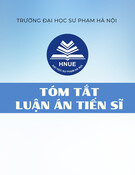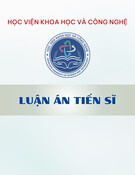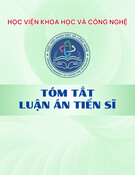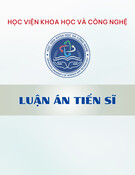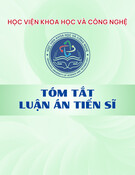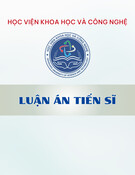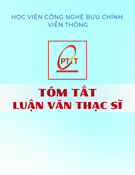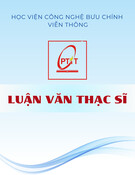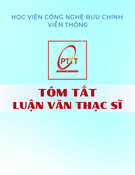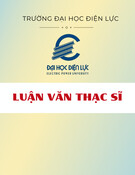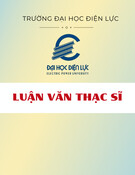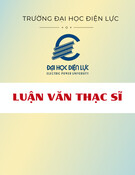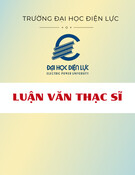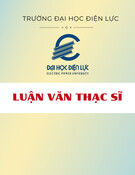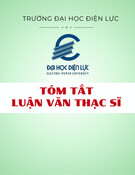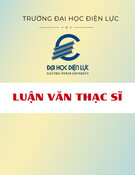
MINISTRY OF EDUCATION
AND TRAINING
VIETNAM ACADEMY
OF SCIENCE AND
TECHNOLOGY
GRADUATE UNIVERSITY OF SCIENCE AND TECHNOLOGY
-----------------------------
Nguyen Thi Thu Hien
BIOLOGICAL CHARACTERISTICS AND
EFFECTS OF GONADOTROPIN ON
REPRODUCTIVE ABILITY OF COMMON PALM CIVETS
(Paradoxurus hermaphroditus Pallas, 1777) IN CAPTIVITY
Major: Biotechnology
Code: 9 42 02 01
SUMMARY OF BIOLOGY DOCTORAL THESIS
Ho Chi Minh City –2019

The thesis was completed at: Graduate University of Science and
Technology - Vietnam Academy of Science and Technology.
Supervisor 1: Assoc. Prof. Dr. Nguyen Thanh Binh
Supervisor 2: Assoc. Prof. Dr. Nguyen Thi Phuong Thao
Reviewer 1: …
Reviewer 2: …
Reviewer 3: ….
The thesis will be defended at The Thesis Evaluation Council
held at Graduate University of Science and Technology - Vietnam
Academy of Science and Technology at [time][date] [month] [2019].
Thesis can be found at:
- The Library of Graduate University of Science and Technology -
Vietnam Academy of Science and Technology
- The National Library of Vietnam

1
Introduction
1. The urgency of the thesis
The Common Palm Civet (Paradoxurus hermaphroditus
Pallas, 1777) belongs to the Viverridae family, carnivora (Carnivora).
This animal is widely distributed in Central, South and Southeast Asia.
In Vietnam, the civets are widely distributed across the country [7].
Hunting and use of civet taps for different purposes such as
meat, leather, fur, aromatherapy, used in the production of weasel
coffee along with their declining habitat are depleting this species in
nature [2, 8]. Preserving and storing genetic resources is one of the
urgent, regular and long-term solutions [9]. In order to sustainably
preserve livestock gene sources, the exploitation and development of
genetic resources is an effective solution [10]. Therefore, in Vietnam,
successfully built many breeding civet farms. The civet farming in
addition to bringing high economic efficiency to the farmers also helps
to reduce hunting and contribute to preserving biodiversity [11].
In breeding management and improvement of the civet
process, studying their biological characteristics and increasing their
reproductive performance are very important. Therefore, the topic
"Biological characteristics and effects of gonadotropin on
reproductive ability of common palm civets (Paradoxurus
hermaphroditus Pallas, 1777) in captivity" is carried out.
2. The aims of the thesis
- Identify biological characteristics, some indicators of
physiological and biochemical blood and urine of civets in captivity.

2
- Determine the change in sex hormones of female civets and
evaluate the effect of sexual stimulation on the fertility of civets in
captivity in order to preserve herd in the direction of quantity
development.
3. The main contents of the thesis
- Study on biological characteristics (appearance, behavior,
growth, reproduction) of the civets in captivity
- Studying on physiological and biochemical parameters of the
civets in captivity.
- Study on the change of sex hormones of the female civets in
captivity.
- Study on the effect of gonadotropin (PMSG, HCG) on the
reproduction of female civets.
CHAPTER 1. LITERATURE OVERVIEW
1.1. Overview of the common palm civets
This section presents an overview of the characteristics of species,
appearance, behavior, reproduction, distribution of species in nature and
current situation of breeding civets.
1.2. Overview of research on the common palm civets
This section presents research on the civets in the world and in
Vietnam. The studies mainly focused on the behavior, physiological and
biochemical characteristics of this species in nature, in terms of genetic
diversity and phylogeny.
1.3. Overview of PMSG and HCG
An overview of structure, functions, applications and studying of
the use of PMSG and HCG in livestock.
1.4. Overview of estrogen and progesterone

3
An overview of the structure and function of estrogen and
progesterone; method of extracting and identifying them through faeces.
CHAPTER 2. MATERIALS AND METHODS
2.1. Location, time of study
2.1.1. Location
- Biotechnology Application Center (Biotechnology) in Xuan
Duong commune, Cam My district, Dong Nai province.
- Thanh Long Wildlife Farm, Thu Duc District, Ho Chi Minh
City.
- Experimental Research Center Thu Dau Mot University.
- Center for Animal Biotechnology - Southern Animal
Husbandry Institute.
2.1.2. Time: from May 2016 to March 2019.
2.2. Farms, food, water
2.3. Contents and methods
2.3.1. Study some biological characteristics of the civets in captivity
2.3.1.1. Material
Growth characteristics: Select 64 individuals (32 males, 32
females) to monitor the growth indicators continuously from 3 to 24
months of age.
Reproductive characteristics: Conducted follow-up on 32 female
civets and 34 male civets before sexual maturity; 42 mature female
civets
2.3.1.2. Survey targets
- Physical characteristics, some adaptive behavior of the civets in
captivity: activity, nutritional characteristics.


